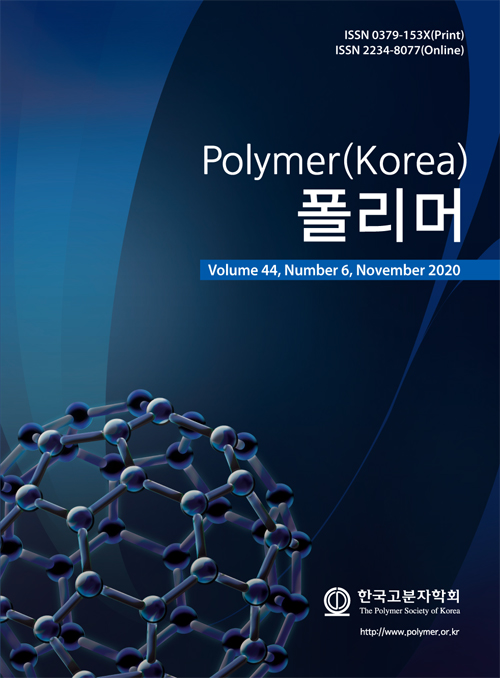- Preparation and Electromagnetic Interference Shielding Properties of Poly(L-lactic acid) Composite Film with Electrically Conductive Polyacrylonitrile Fibers Aligned Inside
*Quality Management Department, Defense Agency for Technology and Quality, Jinju 52851, Korea
**Department of Organic Materials and Fiber Engineering, Soongsil University, Dongjak-gu, Seoul 06978, Korea- 내부에 폴리아크릴로니트릴 도전섬유가 배열되어 있는 폴리(L-락트산) 복합 필름의 제조와 전자파 차폐 특성
*국방기술품질원 품질경영본부, **숭실대학교 유기신소재·파이버공학과
A study was conducted to solve
the problem of low shielding performance of composite materials used for
electromagnetic interference shielding because conductive materials are not
uniformly dispersed or oriented in the polymer matrix. For this, electrically
conductive polyacrylonitrile (c-PAN) fibers that do not melt and have a
high decomposition temperature and poly(L-lactic acid) (PLA) fibers
having a low melting point and showing biodegradability were mixed in several
ratios and aligned in the longitudinal direction to make blended slivers. c-PAN
fiber/PLA composite films were prepared then by melt-pressing the blended
slivers at 200 °C, and their several properties including electromagnetic
interference shielding property were analyzed. The c-PAN fibers were
aligned in the machine direction in the composite film. The electromagnetic
interference shielding efficiency as well as the thermal conductivity of the
composite films increased as the content of c-PAN fibers increased. The
composite film with a c-PAN fiber content of 20% and a thickness of
1.6 mm exhibited a shielding efficiency of 20 dB or more in the entire
frequency range, and an excellent shielding efficiency of about 30 dB at
1000 MHz frequency.
전자파 차폐에 사용되는 복합재료에서 도전성 물질이 고분자
매트릭스 내에 균일하게 분산 또는 배향되지 못하여 차폐성능이 떨어지는 문제점을 해결하기 위한 연구를 진행하였다. 이를 위하여 용융되지 않고 분해온도가 높은 도전성 폴리아크릴로니트릴(c-PAN)
섬유와 생분해성을 가지면서 융점이 낮은 폴리(L-락트산)(PLA) 섬유를 몇 가지 비율로 혼합하고 길이 방향으로 정렬된 혼섬 슬라이버를 제조한 후, 이를 200 °C에서
용융압착시켜 c-PAN 섬유/PLA 복합체 필름으로 제조하고 이들의 전자파 차폐성을 포함한 몇 가지 특성들을 분석하였다. c-PAN 섬유는 복합체 필름 내에서 기계 방향으로 배열되어 존재하며, c-PAN 섬유의 함량이 증가할수록 복합체의 전자파 차폐효율 뿐만 아니라 열전도도가 증가하였다. c-PAN 섬유 함량이 20%이면서 두께가 1.6 mm인 복합체 필름은 전 주파수 영역에서 20 dB 이상의 차폐효율을 보이면서, 1000 MHz 주파수에서는 30 dB 정도의 우수한 차폐효율을 나타내었다.
Keywords: poly(L-lactic acid) fiber, electrically conductive polyacrylonitrile fiber, electromagnetic interference shielding, blended sliver, composite film.
- Polymer(Korea) 폴리머
- Frequency : Bimonthly(odd)
ISSN 0379-153X(Print)
ISSN 2234-8077(Online)
Abbr. Polym. Korea - 2023 Impact Factor : 0.4
- Indexed in SCIE
 This Article
This Article
-
2020; 44(6): 881-890
Published online Nov 25, 2020
- 10.7317/pk.2020.44.6.881
- Received on Sep 9, 2020
- Revised on Oct 13, 2020
- Accepted on Oct 14, 2020
 Correspondence to
Correspondence to
- Young Ho Kim
-
Department of Organic Materials and Fiber Engineering, Soongsil University, Dongjak-gu, Seoul 06978, Korea
- E-mail: ssyhkim@ssu.ac.kr










 Copyright(c) The Polymer Society of Korea. All right reserved.
Copyright(c) The Polymer Society of Korea. All right reserved.